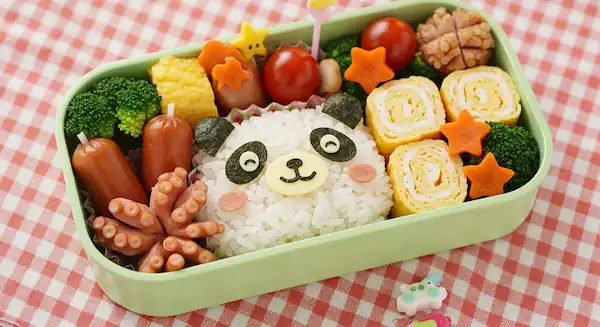The Art, History, and Heart of Japan’s Bento Culture
From ancient times, a deep-rooted tradition of bringing homemade meals, known as bento, has been part of Japanese life for both children and adults.
For train journeys, the ekiben (station bento) is essential, while in cities, warm hokaben (hot bento) are easily accessible.
More recently, the artistic charaben (character bento) has gained global attention.
For the Japanese, bento is more than just a container for food; it’s a deeply integrated part of life and culture.
Table of Contents
A bento is often described as a “diorama of Japanese food culture.”
It’s not just about enjoying delicious food, but also about a sensory experience – a “microcosm” to be savored with all five senses.
You can visually enjoy the colorful arrangement, feel the smooth texture of a lacquered bento box, and appreciate the meticulous attention to detail.
This precise care and aesthetic sensibility symbolize the fusion of detail-oriented craftsmanship and practicality that defines Japanese culture and holds the key to understanding why bento has such a profound place in the Japanese heart.
The Roots of Bento: A Journey Through History
While the concept of bento is ancient, the name “bento” is said to have originated in the Azuchi-Momoyama period.
However, the history of portable meals goes back even further.
In the Heian period classic The Tales of Ise, dried rice called kareii appears.
This was a practical, portable meal for nobles on their travels and for samurai during combat.
Japanese rice has a characteristic of not losing its flavor when cold, and these early bentos were simple affairs of rice with pickled plums (umeboshi) and other pickles.
Meanwhile, during the Azuchi-Momoyama period, when the word “bento” was born, it was still a luxury for the upper class.
A teijū, a type of bento box, was used for outings like cherry blossom viewing and autumn leaf peeping.
The teijū was a functional structure that included serving plates, chopsticks, and even sake cups, and its limited space was filled with a beautiful variety of dishes.
People of that time are believed to have enjoyed this “microcosm” of a bento with all their senses.
The origin of bento, therefore, has two distinct strands: the practical, portable meal and the luxurious feast for the upper class.
This duality laid the foundation for bento’s later proliferation across all social classes, serving various roles from everyday meals to special-occasion feasts.
The coexistence of functionality and aesthetics from the very beginning suggests that the intricate details and visual appeal seen in modern bento are not just a contemporary trend but a historically cultivated cultural trait.
Bento History Timeline
| Period | Key Events/Characteristics | Related Bento Types | Cultural Significance |
| Heian Period | Appearance of kareii, a practical portable meal | Kareii | Practical meal for travel and combat |
| Azuchi-Momoyama Period | The name “bento” is born; a luxury for the upper class | Teijū | Feast for outings, the beginning of aesthetics |
| Edo Period | Popularization among commoners, use for outings and theater | Koshibento, Makunouchi Bento | Fusion with popular culture, a step toward an everyday meal |
| Meiji Period | Compulsory education begins, school bento becomes common, ekiben is born | School bento, Ekiben | Popularized as an everyday meal, culture of travel |
| Post-War to Present | The rise of the chushoku industry, renewed value of homemade bento, birth of charaben | Convenience store bento, Hokaben, Charaben | The pursuit of convenience and individuality, globalization |
From Edo to Meiji: A Shift to Popular Entertainment and Everyday Meals
In the mid-Edo period, the development of major highways led to increased travel.
This made bento more accessible to common people.
Meals like the koshibento, a bamboo-wrapped rice ball, appeared, and books with tips on packing meals for outings and visits to the sick were published.
A particularly popular form of entertainment for commoners during this time was watching plays, which led to the creation of the makunouchi bento.
The name literally means “between the acts,” referring to the intermission of a play.
While early makunouchi bentos were mostly rice, theater teahouses began to provide them for their patrons with colorful side dishes like kamaboko (fish cake).
Kamaboko, with its beautiful designs and colors, became an essential and widely popular part of the makunouchi bento.
The spread of street stalls for tempura and sushi also contributed to a culture of enjoying casual dining out, which helped bento become a form of food entertainment.
The Meiji period brought significant changes to Japanese society.
The introduction of compulsory education established the habit of bringing bento to school, popularizing it as a daily meal.
Additionally, the development of the railway network led to the birth of the ekiben. In 1888, rice balls with pickled plums were sold at Utsunomiya Station, marking the first official ekiben.
They quickly became “a pleasant companion for a trip,” and a wide variety of ekiben featuring local specialties emerged.
For a long time, vendors would “stand and sell” on platforms, and ceramic teapots called “kisha dobin” were used, making ekiben a beloved part of the travel experience.
The history of bento reflects Japan’s social development and urbanization.
Bento consistently adapted its form and role in response to major social changes – the Edo period’s transportation networks and popular entertainment, and the Meiji period’s educational reforms and railway development – becoming deeply ingrained in people’s lives.
In particular, the “democratization” of fine dining, once a luxury for the upper class, through the makunouchi bento for commoners, illustrates how the aesthetic sensibility in Japanese food culture permeated society as a whole.
Modern Bento’s Diverse Forms: Ekiben, Hokaben, and Charaben
During Japan’s post-war economic boom, the chushoku (prepared meal) industry, including convenience store bentos and supermarket deli foods, brought great convenience.
At the same time, the value of homemade bento was also reaffirmed, leading to a diverse evolution.
The Allure and Evolution of Ekiben
Ekiben reflect the diversity of Japanese food and have been cherished alongside the history of its railways.
Today, there are said to be over 2,000 types of ekiben, making eating them an opportunity to experience a “culinary tour of Japan.”
Many ekiben, such as Kyushu’s “Kashiwa-meshi,” feature dishes that reflect local food culture and history, enriching the travel experience.
The decorative paper wrapping, or kakegami, is also a historical artifact that depicts local scenery and current events, and many people collect them as travel souvenirs.
Ekiben have also evolved beyond simple cold meals, with innovative creations like self-heating bento boxes that warm up with the pull of a string.
This technology speaks to the deep Japanese affection for bento and the desire to enjoy a warm meal while traveling.
In recent years, ekiben events have been held at Gare de Lyon in Paris, and Italian high-speed trains have introduced lunch boxes inspired by Japanese ekiben, spreading their appeal worldwide.

The Arrival of Hokaben and Their Difference from Convenience Store Bentos
As the chushoku industry grew, convenience store bentos became an easy and convenient option.
However, specialty shops called hokaben appeared, which offer freshly packed, warm meals.
Popular chains include Hotto Motto and Hokkahokkatei.
Compared to convenience store bentos, hokaben are characterized by their “one-meal-complete” volume, featuring generous portions of rice and thick, large sheets of nori.
The key difference is that they are served warm, offering a taste closer to a freshly cooked meal.
This evolution addresses the consumer need for convenience while providing a sense of “homemade” satisfaction through warmth and volume.
The Creativity of Charaben and Its Global Spread
The charaben is a symbol of modern bento culture.
It takes the playful spirit of old homemade bento – like making apple bunnies or octopus-shaped sausages – to the next level, using rice and other ingredients to create animals and anime characters.
Charaben began with a parent’s love and playful spirit to delight their children.
Charaben are now recognized as works of art that make people “excited and almost reluctant to eat them.” Their greatest appeal is not just their visual impact, but the fact that they are entirely made of edible ingredients. Shared on social media platforms like Instagram and Twitter, photos of charaben have reached a global audience, creating a growing fanbase worldwide.
Modern bento, therefore, offers a wide range of choices, from the convenience-focused convenience store and hokaben options to the artistic, heartfelt creations of charaben.
This shows how modern society’s demand for efficiency and the Japanese cultural values of personal expression and homemade warmth coexist and evolve within bento.
The global spread of charaben, in particular, demonstrates the potential for Japan’s unique food culture to transcend borders by combining visual appeal with modern technology like social media.

Why Do the Japanese Love Bento? The Cultural Context
The deep Japanese affection for bento is not simply about the convenience of carrying a meal.
It’s rooted in a multi-layered set of values within Japanese culture.
Aesthetic Sense and the Joy of Five Senses
Japanese bento is often described as “a work of art.”
The arrangement and color are meticulously planned so that when the lid is opened, the meal is enjoyed in its best visual and flavorful state.
The careful placement of dishes to prevent flavors from mixing while still creating a beautiful presentation reflects the traditional Japanese value of “refinement” in cuisine.
Bento is designed as a “microcosm” to be enjoyed with all five senses – taste, sight, and even touch.
Nutritional Balance and Seasonal Ingredients
A strong emphasis is placed on nutritional balance and the use of seasonal ingredients. Ingredients are chosen to reflect the changing seasons: cherry shrimp and bamboo shoots in spring, colorful summer vegetables, Pacific saury and chestnuts in autumn, and hot pot ingredients in winter.
This practice reflects the Japanese food culture’s core value of appreciating the blessings of nature and the changing seasons.
The ancient practice of including pickled plums for their antibacterial properties also shows a long-standing concern for health.
Convenience and Practicality
Bento is an indispensable part of daily life for children, students, and workers.
Its practicality – easy to carry and nutritionally sound – is widely accepted.
In Japan, a vast variety of bentos are easily available at nearly every convenience store, and the bento industry is a massive market with annual sales of ¥6 trillion.
The evolution of bento boxes to meet diverse needs – with features like spaces for ice packs, convenient sizes for bags, and durable, microwave-safe materials – further enhances their practicality.
An Expression of Love and Communication
Homemade bento, epitomized by the term “aisaibento” (bento made by a loving wife), is an important way to convey care and affection.
The social norm of a mother making a homemade bento is seen as a way to deepen communication and express love to her children.
For a child, a parent’s time and effort in making a bento is a clear “sign of affection” and is crucial for developing a positive relationship with food.
Interestingly, research shows that many people believe a bento that conveys love is not about cute appearances like heart shapes, but one that is “mindful of nutrition and health.”
Similarly, when making a bento for a husband or boyfriend, the preference is for a “hearty, filling meal” rather than a “colorful finish.”
This shows that in Japanese culture, “thoughtfulness” is not just about superficial beauty but about a substantive consideration for the other person’s health and satisfaction.
A bento is made with the recipient’s visual enjoyment, health, and convenience in mind, and this meticulous care embodies the spirit of omotenashi (hospitality) at the root of Japanese culture.
What Bento Nurtures: Food Education and Communication
Making a bento is more than just preparing a meal; it’s a vital opportunity for food education and communication.
Shokuiku (Food Education)
Through bento-making, children can learn a lot about food.
They learn about the nutritional value and uses of various ingredients, naturally understanding the importance of a balanced diet.
For example, teaching them about the different nutrients provided by various colors and types of vegetables helps cultivate health awareness.
Creating a visually beautiful bento with colorful ingredients also fosters children’s imagination and creativity, serving as a means of self-expression.
When faced with challenges like a mistake in the recipe or a missing ingredient, they learn to think about how to solve the problem, which also builds problem-solving skills.
Communication and Social Skills
Bento-making is a “crucial act” that promotes parent-child communication.
Talking about the contents of the bento or asking for feedback on it provides a great opportunity to deepen the bond.
For a child, the bento made with a parent’s time and effort is a tangible expression of love.
Furthermore, at school, comparing their bento with friends’ can be a great conversation starter and a way to build social connections.
Through this interaction, children learn about others’ food preferences and diverse food cultures, helping them develop social skills.
Bento, therefore, serves as an important tool for children to learn social skills and build relationships, not just within the family but also in a wider context.
It acts as a “hidden curriculum” that, unlike a collective school lunch, uses the home environment to pass on core Japanese values like gratitude for food, avoiding waste, and being considerate of others.
Bento Culture Goes Global
Japanese bento culture, especially the artistic charaben and diverse ekiben, is gaining significant global attention.
Foreigners are often surprised by the astonishing variety and the convenience of being able to buy them easily at convenience stores.
They particularly praise the aesthetic beauty, intricate arrangement, good nutritional balance, and use of seasonal ingredients.
The creativity of charaben and innovative technologies like self-heating ekiben also attract international interest.
Many foreigners are “shocked” by the habit of eating cold bento or the use of pickled plums for their antibacterial properties, but they are also deeply impressed by the profound thoughtfulness behind these practices.
This global appreciation shows that it’s not just about the deliciousness of the food, but the “omotenashi” spirit and attention to detail inherent in Japanese culture that resonates with people worldwide.
The influence is spreading in tangible ways, with Japanese restaurants selling bento in the US, ekiben sales events held at major train stations in Paris, and Italian high-speed trains introducing lunch boxes inspired by Japanese ekiben.
Charaben, in particular, has become an international phenomenon, with its appeal quickly spreading across the globe through visual social media platforms like Instagram and Twitter. Bento acts as a “cultural ambassador,” conveying the diversity, creativity, and meticulous care of Japanese food culture, and deepening people’s understanding of and interest in Japan.
In Conclusion: Bento Speaks to the Japanese Heart
Bento is not just a box filled with food.
It is a profound expression that condenses the history and culture of Japan.
From the practical meals of the Heian period to the luxuries of the Azuchi-Momoyama period, the popular entertainment of the Edo period, the daily meals of the Meiji era, and the diverse evolution and international spread of today, bento has constantly adapted to the times, changing its role while remaining deeply rooted in the lives of the Japanese people.
Bento embodies various values that form the core of Japanese culture:
- Aesthetic Sense
The pursuit of beauty integrated into daily life, with colorful arrangements and an appreciation for the beauty of the container, all designed to delight the eater. - Thoughtfulness
The meticulous care for the recipient’s health and preferences, including nutritional balance, seasonal ingredients, and sometimes a message of love. - Ingenuity
The skill of beautifully arranging diverse dishes in a limited space and the relentless innovation behind creations like self-heating bento and charaben. - Seasonal Awareness
The symbol of Japanese food culture’s appreciation for the blessings of nature and the changing seasons by incorporating seasonal ingredients. - Connection
Its role as a medium for nurturing communication and deepening relationships between parents and children, families, and friends.
The history of bento tells a story of Japanese cultural characteristics where functionality and aesthetics have always coexisted, and practicality and spiritual richness have developed as a single entity.
The remarkable adaptability and evolution of bento symbolize the resilience and flexibility of Japanese culture.
Bento will continue to change its form, enriching the daily lives of the Japanese people and captivating people around the world.
Truly, bento is the very heart of Japan.
Would you like to explore a specific aspect of bento culture in more detail, such as the art of making charaben or the history of ekiben?
References
- SHUN GATE: The fascinating small box of Japanese bento culture
- JR Kyushu: Ekiben reflect the trends of the times
- Ajinomoto Food Culture Center: Ekiben
- MARUHA NICHIRO: Survey on lunch boxes
- Wikioedia: Bento










Leave a Reply